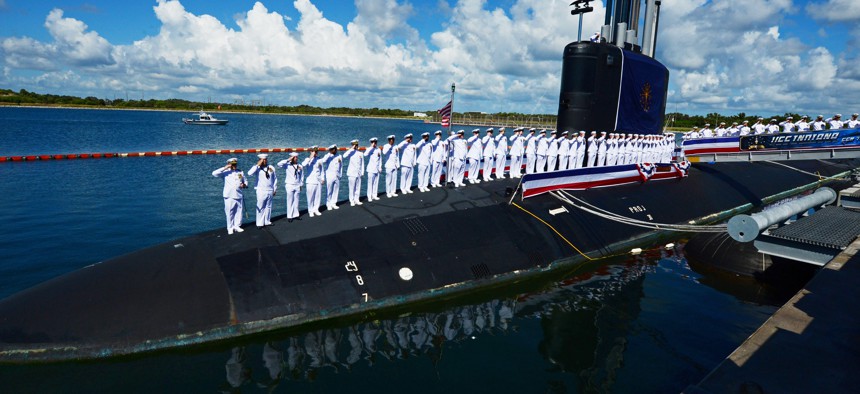
In this 2018 photo, the crew of USS Indiana salutes during the commissioning ceremony of the USS Indiana, the Navy's 16th Virginia-class fast-attack submarine and the third ship named for the State of Indiana, in Port Canaveral, Florida. U.S. Navy / Senior Chief Petty Officer Leah Stiles
Navy’s plans for three new submarines could be held up by budget drama
Secretary Del Toro has also directed an initiative to find efficiencies within new budget caps.
The Navy could have to wait months to start building its second Columbia-class submarine if Congress does not pass defense spending bills by Oct. 1—and could face funding cuts if lawmakers can't do it by year's end.
The 2023 Fiscal Responsibility Act requires Congress to pass all the appropriations bills by Jan. 1 or agencies will face a one percent across-the-board cut, known as a sequester, based on 2023 levels, Russell Rumbaugh, assistant Navy secretary for financial management and comptroller, said Tuesday during an Atlantic Council event.
The act also capped discretionary funding for the 2024 and 2025 budgets and suspended limits on federal debt until Jan. 1, 2025, according to the Congressional Budget Office.
The House was supposed to take up the defense appropriations bill on Wednesday, but some Republicans still don’t support it, so it would not make it past an initial vote, Politico reported. The Senate passed its version on July 27, before leaving for the August break. Once the House passes its final version, the two bills will have to go through conference to resolve the differences.
The Fiscal Responsibility Act did not anticipate having a budget passed before the fiscal year started in October, but is aimed at guaranteeing it is done by the start of the calendar year in January, Rumbaugh said.
“And yet, despite the stability and responsibility the Fiscal Responsibility Act was supposed to give us across the U.S. government—passed by both chambers of Congress—we’re instead heading into FY 24 on unstable and uncertain footing. There are real consequences,” Rumbaugh said.
“If we face the sequester in January, the Department of the Navy would eat a $15 billion reduction, just less than half of what we think [will be] DOD’s total that gets meat-cleavered,” he said, based on an assessment by his team. “ If we avoid a sequester, but are stuck in a full year CR, we would have over $26 billion misaligned.”
If the Pentagon ends up with a CR, the Navy won’t get the five percent funding increase it planned for in its 2023 budget, the second Columbia submarine, or two Virginia-class submarines that are in their 2024 budget, Rumbaugh said.
As the Navy faces two years of budget caps from the Fiscal Responsibility Act, Rumbaugh said, the service has launched an initiative to find efficiencies, called “Running Fix.” The name is “a nautical term that allows you to gauge where you are as you navigate across the seas,” he said.
“That is exactly what we are doing. We are going to start by putting out a call across the department for ways we can do what we're doing better. More efficiently and more effectively. To have a better idea of where we are to make sure we get where the secretary has charged us to be,” Rumbaugh said. “I've gotten advice from senior leaders who have run similar efforts, and they emphasize how many good ideas are waiting out there. We're going to go look for them. And we're going to incentivize those good ideas by letting organizations, and hopefully even people, keep the savings they identify.”
The initiative, directed by Secretary Carlos Del Toro, will not be about “slashing things,” but finding and selecting ideas “that have the highest payoffs, both to help us live under the caps and do what we do for the nation better,” he said.
Still, efficiency advocates should not hold their breath for a quick turn around on the changes.
“[T]he explicit direction is do this right, take your time. So that means we're shooting for the [2026 Program Objective Memorandum] build,” Rumbaugh said. “The 26 POM build is just kicking off. It doesn't actually hit the public world, the president doesn't submit it, until February of 2025.”



